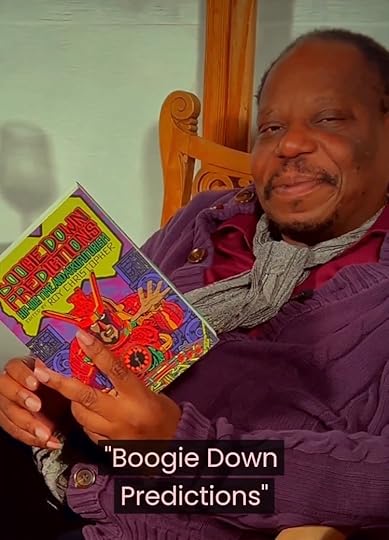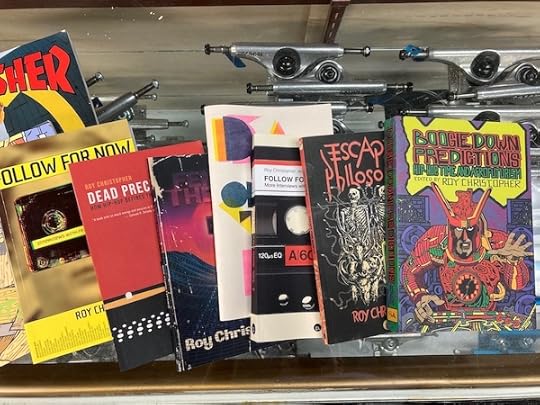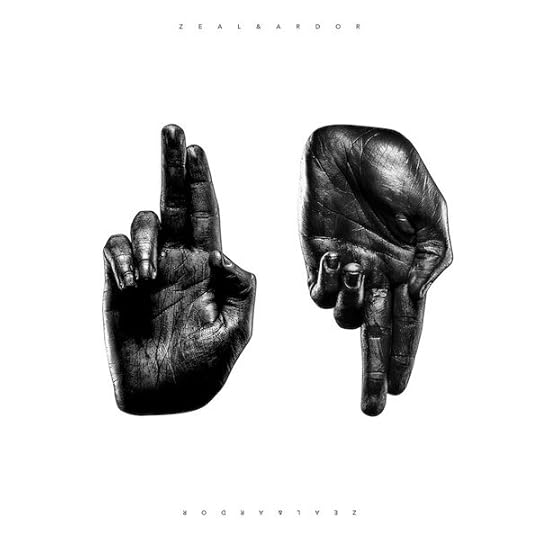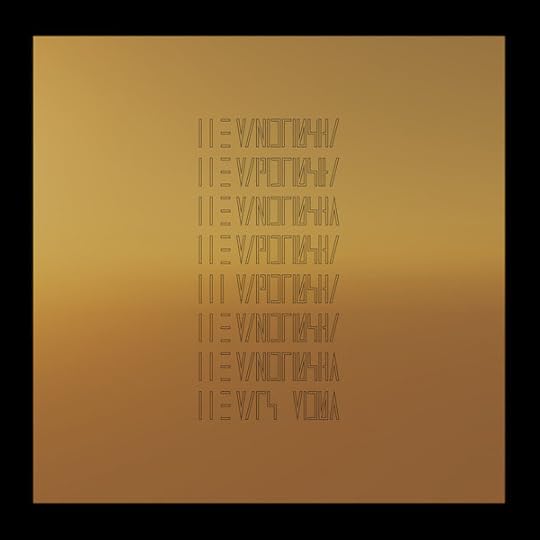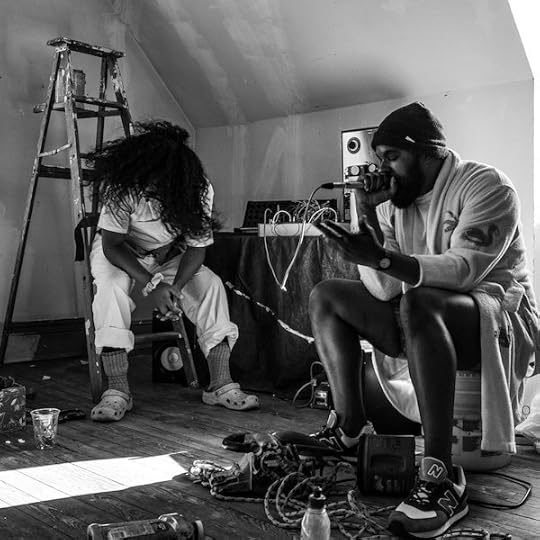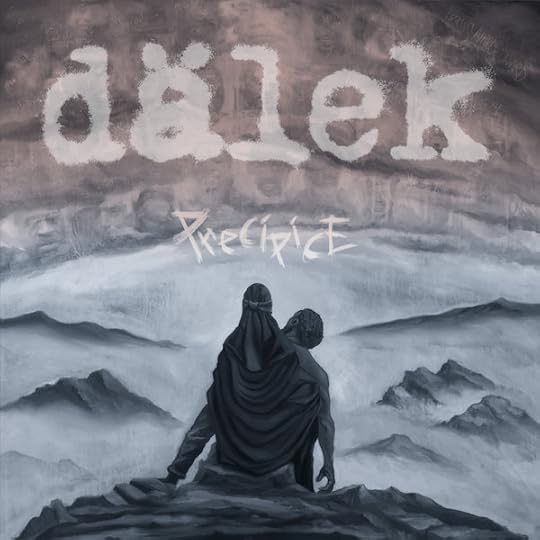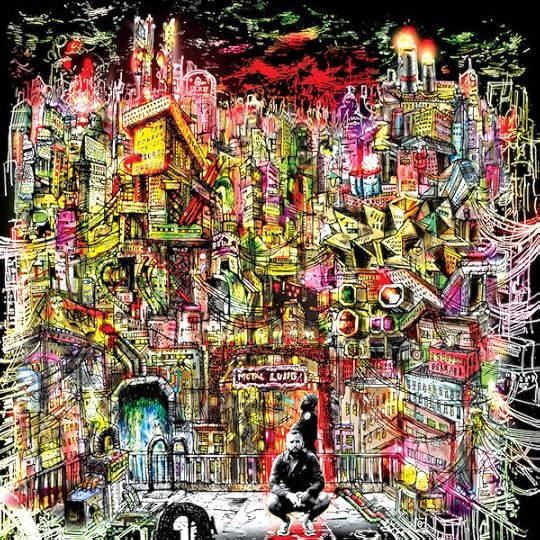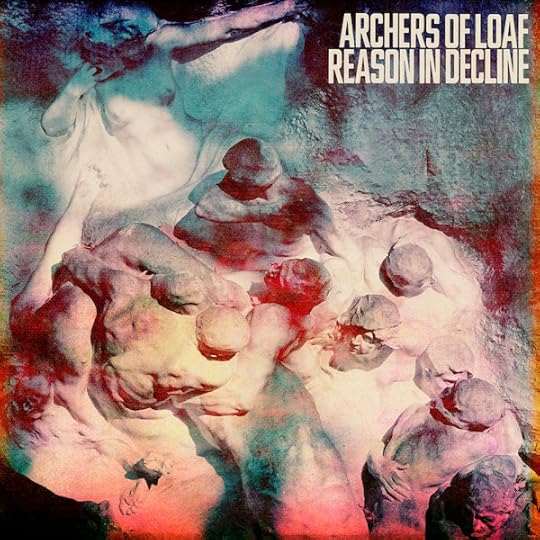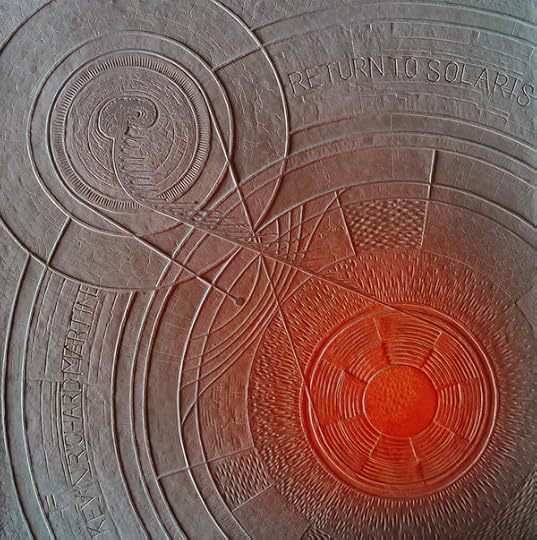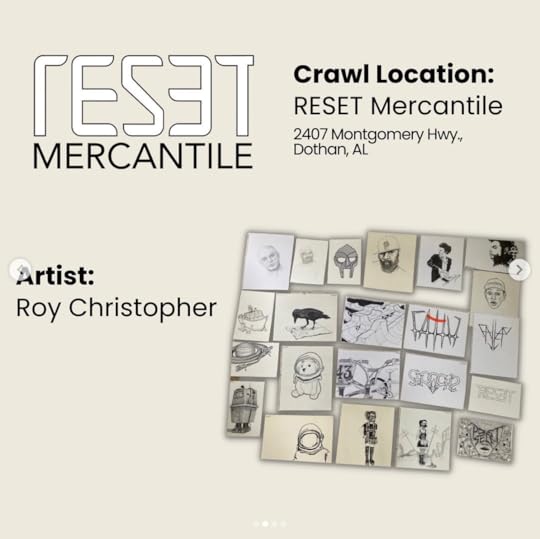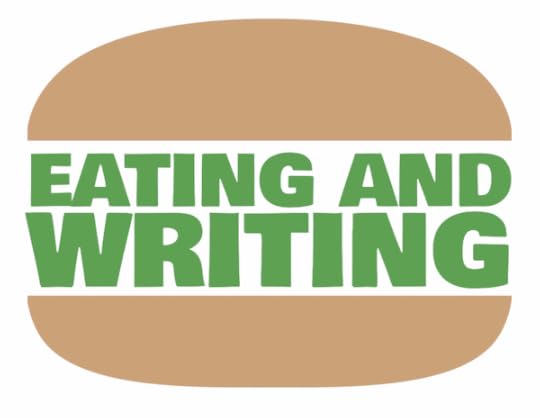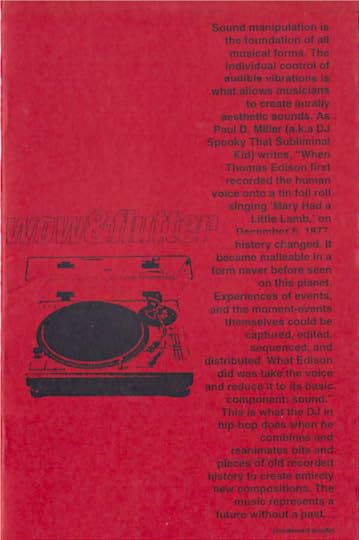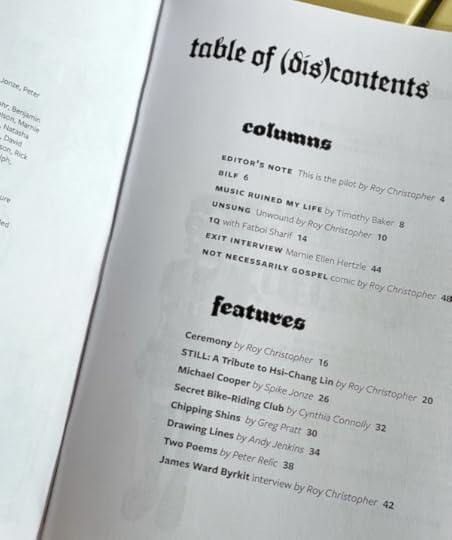Roy Christopher's Blog, page 11
December 16, 2022
Half-Off DEAD PRECEDENTS
 Dead Precedents: How Hip-Hop Defines the Future is 50%-off until the end of the year from Repeater Books! Get one for yourself and a friend. It makes a great gift for the hip-hop head in your family or crew: https://repeaterbooks.com/product/dea...
Dead Precedents: How Hip-Hop Defines the Future is 50%-off until the end of the year from Repeater Books! Get one for yourself and a friend. It makes a great gift for the hip-hop head in your family or crew: https://repeaterbooks.com/product/dea...
December 9, 2022
Recommendations and a Request
Charles Mudede is a senior staff writer at The Stranger, “Seattle’s Only Newspaper,” and he recently started doing a video series called Mudede’s Book Nook. In the third installment of the series, Charles recommends our own Boogie Down Predictions, which, as you know, is a collection of essays edited by me and published by Strange Attractor Press.
He writes,
Because a big part of the only life I’ll ever have is devoted to books, the best thing I can offer during this holiday season is a recommendation of five books you can read by a fake fire (like the one in my cottage) or gift those who happen to be close to your life or who you want to be close to your life.
See the relevant video here (You really want to watch this. There's a cat!):

Many, many thanks to Charles and The Stranger for recommending this book. We worked very hard on it. Find out more, give it as a gift, or treat yourself to your own copy.
Dead Precedents 50%-Off Sale![Dead Precedents with the hands from Run the Jewels' RTJ3. Hands and photo by Timothy Saccenti.]
Repeater Books is having a 50%-off sale on all titles including my own Dead Precedents: How Hip-Hop Defines the Future until the end of the year! Get one for yourself and a friend. It makes a great gift for the hip-hop head in your family or crew. If you don't know, now you know. It's so dope.
BOOKS = GIFTSSpeaking of, all of my books make great gifts! Check them out!
BLOG is a Four-Letter WordAs I reassess what I'm doing with social media and this mailing list, I've been slowly adding things to the blog on my website. As an avid reader of this newsletter, you've already seen some of it, but I'm collecting it there for now.
There's somehow both a comfort and a futility in these efforts. Sure, I want to sell books, but only because foremost I want to connect with people over our shared interests and ideas, and books are one way to do it. I'm still at a loss at the best way to do everything else without being a salesperson, but writing and posting sometimes feels like just adding to the noise.
The prevalent forms of indie discourse have shifted several times since I started making zines as a teenager, and it feels like it's happening again. There's an anything goes feeling to it now that again feels both empowering and pointless.
If you've read this far and have a rare, spare moment, I'd love to hear your thoughts. I'm not sad or frustrated -- this isn't a cry for help -- I'm just trying to waste as little of your time as possible.
Thank you!
As always, thanks for reading and responding.
Hope you're well,
-royc.
December 1, 2022
2022 in Recordings
Rabbit, rabbit, white rabbit... We have a lot of little stuff to wrap up here in the last month of the year. So sit back and scroll.
Below is my 15 favorite records of 2022, a bit about my Desert Island MP3s, a 50%-off book sale, details for my pop-up art show this month, and a throwback photo-op.
Read on!
NOTE: Tomorrow is the Last Bandcamp Friday of 2022, during which Bandcamp waives its fees and all of the money spent goes straight to the artists. All of the links in the list below will take you there, so load up your cart today and spend recklessly tomorrow.
2022 in Recordings:Zeal and Ardor Zeal and Ardor (MVKA): Mixing black metal with Black gospel, Zeal and Ardor is a dirge of a different kind. There’s a darkness here other metal bands attempt but never achieve. Band leader Manuel Gagneux once said Z&A is an answer to the question, “What if American slaves had embraced Satan instead of Jesus?” Wonder no more.
More expansive and experimental than previous releases, this is their best yet. Just listen to "Emerison" for evidence. It's such a joyous noise.
The Mars Volta The Mars Volta (Clouds Hill): The Mars Volta are back, albeit with a lighter touch than before, but no less beautiful and exciting. The most mellow songs, like "Vigil" (my favorite here), "Palm Full of Crux," and "Equus 3," are some of the best on their first record in over a decade. It's a pleasant surprise and a welcome return.
Infinity Knives and Brian Ennals King Cobra (Phantom Limb): With a cover reminiscent of KRS-One's Return of the Boom Bap, Infinity Knives and Brian Ennals bring it all back. Ennals drops lines like, "Cruisin' up yo' block on DMT / We the post apocalyptic Run-DMC" while Infinity Knives keeps the backdrop banging. Upon hearing such a blend of beats, rhymes, and vision, one is tempted to say hip-hop gets no better than this, but the truth is that music itself gets no better than this.
Tears for Fears The Tipping Point (Concord): Speaking of comebacks, Tears for Fears are back and better than ever. There hasn't been such a surprisingly triumphant return like this since The Psychedelic Furs released Made of Rain (Cooking Vinyl) in 2020 after almost three decades away. I think I surprised everyone, including myself, with how much I played this one this year.
dälek Precipice (Ipecac Recordings): Not so quietly building their body of work, dälek added another heavy layer with Precipice. As abrasive as their sounds can be, there's a comfort here that hasn't been this evident before. These guys know exactly what they're doing, and they're doing it better than ever.
Chat Pile God's Country (The Flenser): Chat Pile brings a new level of noisy metal with hints of hardcore and even shades of new wave. It's difficult to nail down their sound, but God's Country is as cohesive a statement as they come. As a bonus, they just released their soundtrack for the film Tenkiller (The Flenser). Get up on it.
Elder Innate Passage (Stickman Records): Over their last few releases, Elder has become one of my favorite bands. While I loved Lore and Reflections of a Floating World, it was Omens that really hooked me. It became one of my most listened-to recent records since its release in 2020. All of that amped up my anticipation for Innate Passage, and Elder delivers. If you like your Doom proggy or your Prog doomy, Elder gets the mixture just right.
ShrapKnel Metal Lung (Backwoodz Studioz): I described my mans' last record as what Clipse would sound like if they were on Def Jux. Metal Lung expands their sound beyond my simple comparison. As evidenced once again by last year's Little Robert Hutton and Load Bearing Crows Feet from Curly Castro and PremRock respectively, these two are proven solo stars. But the lyrical interplay between them in ShrapKnel is unmatched.
Shout out to my man Rob Sonic and his verse on "Metal Sum Kids."
Fly Anakin Frank (Lex Records): Sometimes a record is just so solid and you can just listen to it all the time. Frank is like that. It reminds me of repeatedly spinning records like Tame One's Da Ol' Jersey Bastard (R.I.P.), Cool Calm Pete's Lost, or more recently, Mozzy's Beyond Bulletproof. With beats by everyone from Madlib and Evidence to Foisey and Theravada, it's just good.
billy woods Aethiopes (Backwoodz Studioz): A couple of years ago, there was a dumb debate about who should be on the Mt. Rushmore of emcees from the 2010s. I said it should just be four pixelated billy woods faces.
No one has covered Aethiopes more thoroughly than my man Joe Rathgeber in issue #6 of his zine, Caltrops Press, "A Skeleton Key to billy woods Aethiopes." So, you should go read that.
Also, peep billy woods' latest with Messiah Music: Church (Backwoodz Studioz). The man doesn't sleep, and neither should you.
Holy Scum Strange Desires (Rocket Recordings): Mike Manteca (Destructo Swarmbots, dälek) told me that being in Holy Scum is "like being 15 and playing live music for the first time again." You can hear that juvenile fun in this gleeful racket, which also features members of Gnod, Action Beat, and Shuck. I can't seem to play it loud enough.
Archers of Loaf Reason in Decline (Merge): On their first record in 24 years, Archers of Loaf are as edgy and angsty as ever. It's unexpectedly great to finally have new Indie Rawk from one of my all-time favorite bands, but Reason in Decline doesn't sound nostalgic. It sounds as fresh as Icky Metal did when it came out in 1993 -- fresh like a smack on the ass.
Bonus Slice: My friend and resident Archer Matt Gentling also played bass on the new Band of Horses record.
Mogwai As the Love Continues (Temporary Residence): This one is from 2021, but it stayed in rotation all year. Mogwai is still my most-listened-to band, and I am still flabbergasted at how they are doing their best work almost 30 years on. As soon as I heard the lead singles, "Dry Fantasy" and "Ritchie Sacramento," I knew this one was going to linger. Like an aural CAPTCHA code, if you don't get "Ceiling Granny" stuck in your head after the first listen, you might be a robot.
Weyes Blood And in the Darkness, Hearts Aglow (Sub Pop): The middle entry of a trilogy of records from Natalie Mering a.k.a. Weyes Blood, it's hard to put words to this one. Sometimes it sounds like an alternate Twin Peaks soundtrack filtered through 1970s AM radio, and sometimes it sounds like similar dark scenes unfiltered by time or airwaves of any kind. It's beautiful.
Kevin Richard Martin Return to Solaris (Phantom Limb): Somehow I missed this one last year. The Vooruit Arts Centre in Ghent, Belgium invited Kevin Martin to compose a score for a film of his choice. Martin chose Andrei Tarkovsky's classic, Solaris (1972). My favorite film score of all time is Cliff Martinez's Solaris score for Steven Soderbergh's version of this story from 2002, so I got this immediately. "Hauntological" is a big, Derridian word that describes this book and its adaptations. Martin's score is all that and then some.
...
Let me know if there's a record you think I'd like from this year. I'm sure I missed some good ones.
I Want My MP3!I am happily stuck in the MP3 era. It's one of the reasons I always link these lists to Bandcamp and not some streaming service. I tried one of the latter again recently. When the second and third artists I looked up weren't available, I promptly deleted it again.
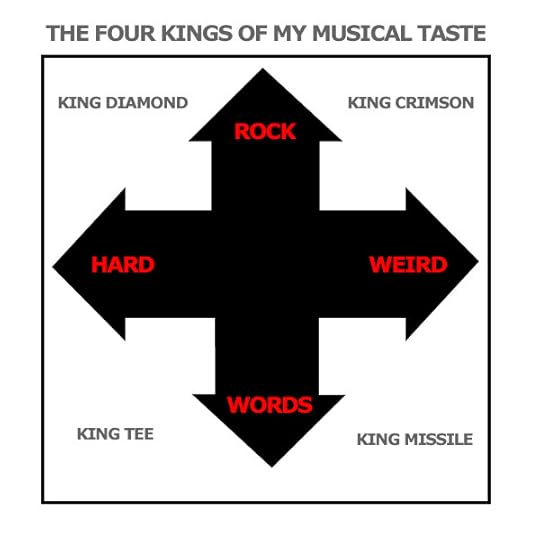
The above chart is my attempt to capture what I like in music. The Four Kings here aren't my favorite artists, but they're representative of the aspects of music I enjoy. I tend to like hard, heavy, noisy, or odd sounds, all with solid lyricism. Clichés are the one thing that I can't seem to get past.
While putting together this year's list, I realized that there are records that never leave the 8-gigs of available space on my iPod Nano. It's an odd mix at best. It's not my favorites or records I consider the best, but ones I just always have with me.
Predictably, there's always some Mogwai, Peter Gabriel, Radiohead, Fugazi, Slayer, and a lot of hip-hop, punk, various strains of metal, and some stuff to fall asleep to, but all of that gets switched out fairly often. These are the records that never leave:
Circle Jerks Group Sex (Frontier)
Germs (GI) (Slash)
Laurie Anderson Strange Angels (Warner Bros.)
The Sisters of Mercy Floodland (Merciful Release)
Barkmarket Gimmick (American Recordings)
The Jesus Lizard Liar (Touch & Go)
My Bloody Valentine Loveless (Creation)
Shudder to Think Pony Express Record (Epic)
Brise-Glace When in Vanitas... (SKiN GRAFT)
The The Mind Bomb (Epic)
Seaweed Four (Sub Pop)
Emmylou Harris Wrecking Ball (Elektra)
Why? Alopecia (Anticon)
Publicist UK Forgive Yourself (Relapse)
Passion Pit Manners (Frenchkiss)
Interpol Turn on the Bright Lights (Matador)
I can't explain why these are the records I never leave home without any better than I can explain why they're also not necessarily my favorites. Fandoms of all kinds are radically subjective, and that's nowhere more evident than in music. It's just like that.
Half-Price Dead Precedents![Dead Precedents with the hands from Run the Jewels' RTJ3. Hands and photo by Timothy Saccenti.]
Repeater Books is having a 50%-off sale on all titles including my own Dead Precedents: How Hip-Hop Defines the Future until the end of the year! Get one for yourself and a friend. It makes a great gift for the hip-hop head in your family or crew. If you don't know, now you know. It's so dope.
The rest of them are on my website. They make great gifts!
Art Show AlertI'll have some of my drawings and logo designs up on the wall this month at Reset Mercantile in Dothan, Alabama. This is my first solo art show, and I couldn't be more stoked on the venue. Many thanks to Justin April for hooking this up.
The First Friday Art Crawl is this Friday, December 2nd from 5-8pm. Come check out my scribblings if you're in the area!
One Last Thing...
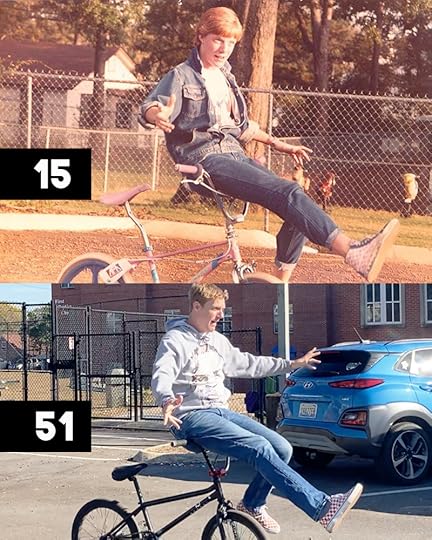
Inspired by Brian Tunney and his zine Larry's Donuts is Dead, I've been wanting to restage this photo from a year-book shoot in 1986. Though you can't tell from the background, I went back to the same church parking lot where the original was taken and did the barhop again. Tunney does this with famous BMX photos and spots from old magazines.
Despite my impeccable fashion sense, this picture didn't even make the yearbook!
Happy December!
Thanks for reading,
-royc.
November 21, 2022
Walk This Way
I was in the tenth grade when Run-DMC's "Walk This Way" came out. I remember hearing it and feeling like something truly unique was happening. Raw, raucous, and rocking. It brought together fans of both traditional rock n’ roll and rebellious hip-hop.
Recently, I pitched the song to a book series specifically about individual songs, but they didn't agree on the impact or the import of it. Well, while I was factchecking my memory, I found out there's already a whole book about it! There's no doubt it was a special moment in music, a new node in a burgeoning network of sound.
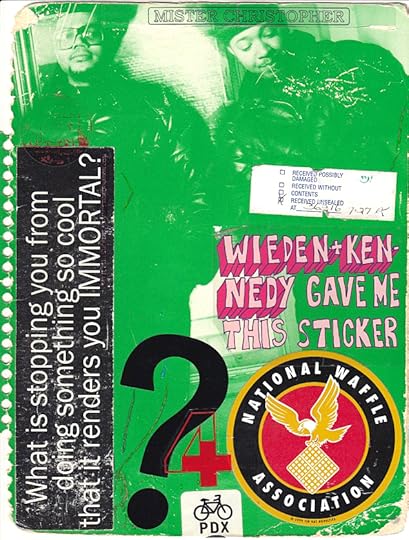
-- Notebook cover I made from the sleeve of Run-DMC's Raising Hell (1986).
Aerosmith’s original version of "Walk This Way," from their 1975 record Toys in the Attic, starts with a few measures of just the beat. It’s just the kind of clean drum beat hip-hop DJs scour recordings to find. With two copies of the record, one can loop it back and forth, providing a seamless backbeat to rap over. Run-DMC's DJ Jam Master Jay had already been using the record in this manner.
In 1986, Aerosmith was in shambles. Their 1985 reunion record Done With Mirrors had not met the expectations of their fans or their label, and their personal lives were in decline due to persisting drug problems. Starting with singer Steven Tyler, they would all enter rehab over the next couple of years. If not, they knew they were likely over as a band. After rehab and collaborating with Run-DMC on "Walk This Way," Aerosmith followed the song with a string of multi-platinum albums and Top 40 hits, entering the most successful era of their careers and becoming one of the biggest rock bands of the 1990s. It was a miraculous turnaround.
Though they hated the idea at the time, Run-DMC’s version of "Walk This Way" is a testament to the ear of their producer Rick Rubin. His production style, which he’d already used on previous Run-DMC records, as well as records for T La Rock & Jazzy Jay, the Beastie Boys, and LL Cool J, was credited as "reduction" instead of production. He stripped their sound down to its basic elements: boom-bapping 808 drums, classic-rock guitar riffs, the shouted voices of Reverend Run Simmons and Darryl "DMC" McDaniels, and the nimble cuts and scratches of Jam Master Jay.

As a nascent record label mogul and producer, Rubin was only getting started. The iconic sound he developed with early hits like "It's Yours," "Rock the Bells," "(You Gotta) Fight for Your Right (to Party)" and "Walk This Way" keep him in demand to this day. He’s gone on to produce everyone from Public Enemy, Ghetto Boys, Sir Mix-a-Lot, and Kanye West to the Mars Volta, Metallica, Tom Petty, Johnny Cash, Lana Del Rey, and Adele, and he’s redone the reduced style of his early work on everything from Jay-Z’s double-platinum "99 Problems" (2003) to Eminem’s Grammy-nominated "Berzerk" (2013), even appearing in the videos for both songs.
Speaking of, the video for "Walk This Way" was as iconic as the song. It starts as a fight, with Aerosmith practicing loudly in one room, disrupting Run-DMC’s session next door. Run-DMC then turns up the volume on their equipment and launches into their version of "Walk This Way," confusing the aged rockers. By the chorus, the wall is torn down (inviting more than a few interpretations), and the two groups are ripping through the song together. The video was even parodied in 1994 by the Jon Spencer Blues Explosion on their song "Flavor" which features Beck in the practice space next door.

For better or worse, "Walk This Way" also sparked the further mixture of rap and riffs, giving birth to collaborations between rap groups and rock groups and a start to acts firmly on the fence in between. Public Enemy and Anthrax covered PE's "Bring the Noise" in 1991. The two groups even toured together that year. I saw them at the University of Alabama at Birmingham in a chocolate-and-peanut-butter package that also included Young Black Teenagers and Primus. In 1993, the infamous Judgement Night soundtrack featured collaborations between Slayer and Ice-T, Sonic Youth and Cypress Hill, and Dinosaur Jr. and Del the Funky Homosapien, among many other embarrassing pairings. And, as if reading "Walk This Way" as a blueprint to success, acts like Limp Bizkit, Linkin Park, and Rage Against the Machine also emerged in the 1990s.
"Walk This Way" was an unavoidable song and an undeniable hit, Run-DMC's biggest, peaking at #4 on the Billboard chart. It was bigger even than Aerosmith's original, which just broke the top ten. Run-DMC is one of the core groups of the first recorded era of rap music and hip-hop culture. They were successful and respected before and after this song, but they never saw heights like "Walk This Way." The song was the nexus of several trajectories and the birth of a hybrid new life form that still stomps around today.
The Edible ComplexI did a piece for Lit Reactor about eating and writing (It's three food-based tips for research and editing). Here's the beginning:
The process of writing is one of those things that eludes even those of us who do it everyday. Sometimes sentences just pour out of you. Sometimes you go weeks with nothing. When I'm in the flow of the sentences, I'm always trying to figure out how to make them the best I can. When I'm in the nothing of the nothingness, I'm always trying to figure out ways to recalibrate my approach. Maybe if I do that part first instead... Maybe if I sneak up on it this way... Maybe if I have a snack...
Eating and writing sometimes feel inextricably linked. They are both done sitting at a table after all. There are also so many things done in the service of eating that aren't eating and in the service of writing that aren't writing. I'm thinking of recipes and cooking done before eating and the cleaning up done after; the planning and research done before writing and the editing done after.
I'm writing about writing here of course, but these ideas are applicable to other creative pursuits as well. So, with lunchtime in mind, here are three food-based tips for research and editing... read the rest at Lit Reactor.
And remember...
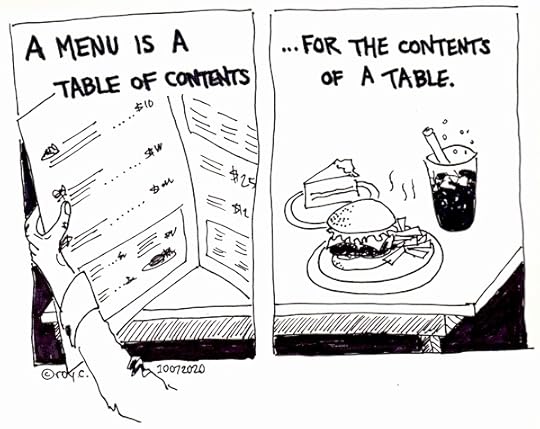

All of my books (pictured above at Reset Mercantile in Dothan, Alabama) make great gifts! At least two of them (Dead Precedents and Boogie Down Predictions) are about historical hip-hop moments like the one above. If you haven't already, cop your copies.
If you have, please consider rating one or posting a review. It helps more than you know.
Thank you!
As always, thanks for reading,
-royc.
[The "Eating and Writing" wordburger above was made with Put Words Between Buns by Ian Bogost.]
November 16, 2022
What's in my NOW?
This week is all about paper and printed products: namely notebooks, zines (old and new), and books, of course.
Read on!
What's in my NOW?
I participated in this week's edition of the Cool Tools What's in my NOW? newsletter, edited by the magical and multi-talented Claudia Dawson. It's a weekly list of one person's things that are influencing their present: 3 physical, 2 digital, and 1 invisible.
I included these great Bienfang Notesketch notebooks. I work on paper as much as I do on screens. I even make my own notebooks. If given the choice, Bienfang Notesketch paper is what I would use for every one. It’s half-ruled—sometimes half the page vertically, sometimes half of it horizontally—and it’s perfect for hashing out ideas of all kinds.
Flashback: wow&flutterIn 1997 I put out a zine called wow&flutter [.pdf]. It was an attempt to merge two of my main musical interests at the time, turntablism and experimental noise. I interviewed DJ QBert, DJ Spooky, John Duncan, and Daniel Menche, and reviewed records from the rapidly expanding releases of ambient, noise, and turntable artists. I lived in Seattle at the time, and there was so much going on in all of these areas. There were regular live events and several specialty stores, and I tried to bring them all together under the banner of sound experimentation.
wow&flutter was intended as the first of a series, but the second issue, attack&decay, featuring interviews with Jack Dangers of Meat Beat Manifesto and Warren Defever of His Name is Alive, among others, never made it to press. I still love the idea of noise and hip-hop coming together, and there are others who’ve merged them in the meantime better than I could have imagined (e.g., dälek, clipping., Ho99o9, Death Grips, Cloaks, Justin Broadrick and Kevin Martin, et al.)
It’s been 25 years since its release, but maybe it’s worth another look. Download this .pdf of the first issue, and you’ll see the seeds of future projects like my recent books Dead Precedents and Boogie Down Predictions.
ICYMI: discontentsThis summer I returned to my roots and made a zine with some of my old zine-making friends. The pilot issue features stories on Ceremony, Hsi-Chang Lin a.k.a. Still, and Unwound; interviews with emcee Fatboi Sharif, Coherence director James Ward Byrkit, and Crestone director Marnie Elizabeth Hertzler; pieces by Cynthia Connolly, Spike Jonze, Andy Jenkins, Timothy Baker, Greg Pratt, and Peter Relic; cover art by Tae Won Yu, layouts by Patrick Barber and Craig Gates, and drawings by me, Zak Sally, and Marcellous Lovelace.
It's 50 solid pages of good stuff about good stuff! Get yours: discontents is still available from Impeller Press.
MY BOOKS:

I redid my website, and now there's a page for all of my books (pictured above at Reset Mercantile in Dothan, Alabama) and a page for each of them. All of the information about each one is available there now. If you haven't already, cop your copies. They also make great gifts!
Thank you for reading,
November 3, 2022
The Grand Allusion
Well, I just signed on to write The Grand Allusion for Palgrave Macmillan as a part of their Pivot series! So, I thought I'd repost my early thoughts on the idea.
Here's my mock cover. Like a lot of allusions, I did it for yuks:
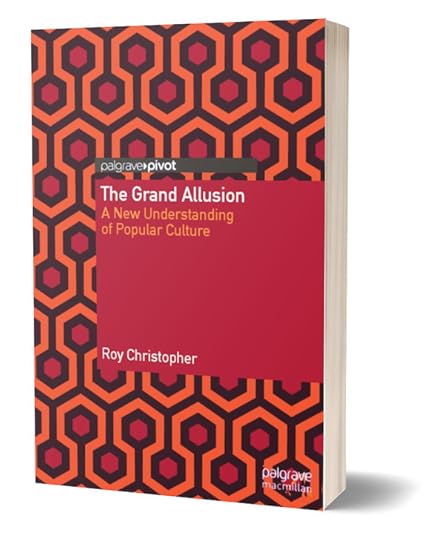
And here's the tentative Table of Contents:
1. Booked Up: The Literary Roots of Allusion
2. Vernacular Homicide: Beyond Intertextuality
3. From Jay to Z: Figurative Language Use in Rap Lyrics
4. Use Your Allusion: Sampling, Collage, Remix
5. Nice to Meme You: Online Idea Exchange
6. Flowers for QAnon: Conspiracies and Supremacies
7. The Grand Allusion: The Future of Reference
There are a lot of tenuously connected ideas bouncing around in the bit below, so thank you for enduring my thinking aloud. I'll be sorting these thoughts out further for the book.
Read on!
Use Your AllusionOn his spoken-word album Bomb the Womb (Gang of Seven) from 30 years ago, Hugh Brown Shü does a great bit about it being 1992, and everything seeming familiar. “What has been will be again,” reads Ecclesiastes 1:9. “What has been done will be done again; there is nothing new under the sun.” That old familiar feeling has been around longer than we’d like to admit, but how do make sense of things that seem familiar but really aren’t?

The first time I heard “The Pursuit of Happiness” by Kid Cudi (2009), I felt like something was a bit off about it. I felt like it had originally be sung by a woman, and he’d just jacked the chorus for the hook. I distinctly remembered the vocals being sung by a woman but also that they were mechanically looped, sampled, or manipulated in some way.

Upon further investigation I found that the song was indeed originally Kid Cudi’s, but that Lissie had done a cover version of it. Her version is featured in the Girl/Chocolate skateboard video Pretty Sweet (2012), which I have watched many times. Even further digging found the true cause of my confusion: A sample of the Lissie version forms the hook of ScHoolboy Q’s song with A$AP Rocky, “Hands on the Wheel.” This last was the version I had in my head and the source of my confusion.
I use this rather tame example to show how easy it is to be unsure about the source of something that we feel like we know. Our memories play tricks, but so do our media. The phenomenon plays out in many other contexts as well.
 -- Dave Vanian of The Damned on the cover of Slash #1, May 1977, and Playboi Carti on the cover of his record Whole Lotta Red, 2020.
-- Dave Vanian of The Damned on the cover of Slash #1, May 1977, and Playboi Carti on the cover of his record Whole Lotta Red, 2020.
The cover art for Playboi Carti’s 2020 record, Whole Lotta Red (AWGE/Interscope) knocks off the lo-fi aesthetic of classic punk magazine Slash. This isn’t the first time Carti’s visual aesthetic has paid homage to punk.
 -- Playboi Carti Die Lit (2018)
-- Playboi Carti Die Lit (2018)
The stage-diving photo on the cover of his 2018 record, Die Lit (AWGE/Interscope), recalls a similar SST promo photo of HR of Bad Brains, who was notorious for doing backflips on stage. It’s closer to Edward Colver’s classic 1981 Wasted Youth live shot, which appeared on the back of their Reagan’s In LP (ICI Productions).
 -- Wasted Youth Regan’s In (1981). Photo by Ed Colver.
-- Wasted Youth Regan’s In (1981). Photo by Ed Colver.
Such allusions are everywhere in our media. They’re also prevalent in human interpersonal communication. The example I always cite for this comes from Adbusters Magazine founder Kalle Lasn. In his 1999 book Culture Jam, Lasn describes a scene in which two people are embarking on a road trip and speak to each other along the way using only quotations from movies. Based on this idea and the rampant branding and advertising covering any surface upon which an eye may light, Lasn argues that our culture has inducted us into a cult: “By consensus, cult members speak a kind of corporate Esperanto: words and ideas sucked up from TV and advertising.” Indeed, we quote television shows, allude to fictional characters and situations, and repeat song lyrics and slogans in everyday conversations. Lasn argues, “We have been recruited into roles and behavior patterns we did not consciously choose” (emphasis in original).
 -- Sometimes it’s not necessarily an homage. Sometimes it’s “inspiration.” Deborah Harry in 1976, and Margot Robbie as Harley Quinn in 2016.
-- Sometimes it’s not necessarily an homage. Sometimes it’s “inspiration.” Deborah Harry in 1976, and Margot Robbie as Harley Quinn in 2016.
Lasn writes about this scenario as if it is a nightmare, but to many of us, this sounds not only familiar but also fun. Our media is so saturated with allusions to other media that we scarcely think about them. A viewing of any single episode of popular television shows Family Guy, South Park, or Robot Chicken yields allusions to any number of artifacts and cultural detritus past. Their meaning relies in large part on the catching and interpreting of cultural allusions, on their audiences sharing the same mediated memories, the same mediated experiences.
In an article from 2015, Devin Blake uses comedy as an example. Pointing to the well-established fact that we no longer define ourselves by what we produce but by what we consume, he marks the rise of what he calls “consumer comedy.” That is, comedy that references other media in order to pack its punchlines. “A lot of what happens in late night TV, for example,” he writes, “seems to involve things that we consume, namely other media like TV shows, movies, and music.” The added knowledge of an allusion is crucial for comedy in that if the audience doesn’t catch a reference, they won’t get the joke. Blake adds the critical insight: “A world of comedy-for-consumers is different than one filled with comedy-for-producers.” The consumption of information is not tethered to the physical world in the way that the production of material goods is.
Marshall McLuhan would frame these media allusions in Gestalt psychology terms as figure and ground. The figure being the overt reference—visual, verbal, or otherwise—and the ground being the invisible referent—the original image or text. “The figure is what appears and the ground is always subliminal,” he wrote. In the visual allusions above for instance, the figure is what you see, and the ground is the source material, the knowledge you have that you’ve seen the thing before, that old familiar feeling. The figure is the artifact at hand, and the ground is the historical context it’s indexing.
 -- Deborah Harry had a Slash cover, too. Issue #5, October 1977.
-- Deborah Harry had a Slash cover, too. Issue #5, October 1977.
So widespread is the use of allusion in our media that it has become its own cultural form. Following allusions on a path through media provides a unique way to understand contemporary mediated culture. Because allusion relies on shared media memories, exploring its use and function in media and conversation helps answer questions of how such mediated messages are stored, conceived, retrieved, and received.
Allusive tactics are not limited to television shows, movies, music, and conversations. Users employ them on social media as a form of “social steganography.” That is, hiding encoded messages where no one is likely to be looking for them: right out in the open. In one study, a teen user has problems with her mother commenting on her status updates. She finds it an invasion of her privacy, and her mom's eagerness to intervene squelches the online conversations she has with her friends. When she broke up with her boyfriend, she wanted to express her feelings to her friends but without alarming her mother. Instead of posting her feelings directly, she posted lyrics from “Always Look on the Bright Side of Life.” Not knowing the allusion, her mom thought she was having a good day. Knowing that the song is from the 1979 Monty Python movie, Life of Brian, and that it is sung while the characters are being crucified, her friends knew that all was not well and texted her to find out what was going on.
 -- Howling on hallowed ground: Jake Angeli a.k.a. the QAnon Shaman.
-- Howling on hallowed ground: Jake Angeli a.k.a. the QAnon Shaman.
Social steganography is not always so innocuous. Media allusions are arguably more vital on social media where memes are the currency exchanged. Conspiracy theories are spread online through shared texts as their adherents rally around allusions to those texts. The hidden knowledge allows these groups to communicate with each other out in the open without alarming others or stirring up ire or opposition. So-called “dog whistles,” these allusions are shibboleths shared by members and ignored by others. QAnon has largely shared references to their own rumors and accusations, but other texts like William Luther Pierce's The Turner Diaries and the Luther Blissett Project’s novel Q are also touchstones. On the possible connections between the Q of QAnon and the Q novel, Luther Blissett member Wu Ming 1 says, “Once a novel, or a song, or any work of art is in the world out there, you can’t prevent people from citing it, quoting it, or making references to it.”
If we’re all watching broadcast television, we’re all seeing the same shows. If we’re all on the same social network, no two of us are seeing the same thing. The limited access to content via broadcast media used to unite us. Now we're only loosely united via the platform, and the platform itself doesn't matter. What matters is ephemeral and esoteric knowledge, knowing the memes, getting the references, catching the allusions. The references are stronger than their original media vessels. As less and less of us share the ground of each figure, the latter outmodes the former as it shrinks. Whether images from other media or quotations from a text, the allusions themselves outmode the vehicles that carry them.
Get a Spine!In much less exciting news, I've been updating my website. I added a dedicated page for each of my books so far (spines pictured above) as well as one for all of them. Check 'em out! They make great gifts!
As always, thank you for reading, responding, and sharing!
Power to you,
-royc.
Bibliography for the Essay Above:
Blake, Devin, “The Rise of Consumer Comedy,” Splitsider, 2015 [archived here].
Blissett, Luther, Q: A Novel. Portsmouth, NH: Heinemann, 2003.
boyd, danah & Marwick, Alice E. Social Privacy in Networked Publics: Teens’ Attitudes, Practices, and Strategies. Paper presented at Oxford Internet Institute’s A Decade in Internet Time: Symposium on the Dynamics of the Internet and Society, Oxford, England, September 22, 2011.
Brown Shü, Hugh, Bomb the Womb, New York: Gang of Seven, 1992.
Brunton, Finn & Nissenbaum, Helen, Obfuscation: A User's Guide for Privacy and Protest. Cambridge, MA: MIT Press, 2015.
Frankel, Eddie, QAnon: The Italian Artists Who May Have Inspired America’s Most Dangerous Conspiracy Theory, The Art Newspaper, January 19, 2021.
Greaney, Patrick. Quotational Practices: Repeating the Future in Contemporary Art, Minneapolis, MN: University of Minnesota Press, 2014.
Lasn, Kalle, Culture Jam: The Uncooling of America, New York: Eagle Brook, 1999, p. 53.
McLuhan, Marshall, Understanding Media, New York: Houghton-Mifflin.
Molinaro, Matie, McLuhan, Corinne, & Toye, William (Eds.), Letters of Marshall McLuhan, New York: Oxford University Press, 1987.
Pierce, William Luther (as Andrew Macdonald), The Turner Diaries, Charlottesville, VA: National Vanguard Books, 1978.
October 21, 2022
Raking Leaves
For the last couple of weeks I've been busy with writing and editing The Medium Picture (forthcoming from Zer0 Books) as is usual these days, but also made a public appearance, released a new excerpt, celebrated an anniversary, and kicked off a new project (more on the latter later). All the details follow.
Read on!
Hope for Boats: A Prologue
Last week I read the prologue to my novel-in-progress, Hope for Boats, to the Rotary Club of Elba, Alabama, on which Elbo, the fictional town in the story, is loosely based. Here's the clip. You can read along on the Malarkey Books site.
Thanks to the members of the Elba Rotary Club, Courtney Pelham for inviting me, and my sister, Cindy, for filming.
[Boat drawing by me.]
Escape Philosophy excerpt on Apocalypse Confidential
Apocalypse Confidential is currently running an excerpt from Escape Philosophy: Journeys Beyond the Human Body (punctum books). Self-described as "Notes From The Underworld, Excavating The Carcosan Aspect; ‘Psyop Sleaze Rag’," Apocalypse Confidential is now running Chapter 2, "Body: The Root of all People." Here's a bit:
All the World's a Grave
It’s not like it looks on TV. You never see the open torso of a body heaving and sucking after a bullet, a piece of shrapnel, or a chunk of flying concrete has ripped right through it. The worst part is the smell: somewhere between bad breath and warm shit. And it’s inescapable. If the blood and guts get to be too much, you can look away. You can’t get way from the smell.
Bodies are gross. Getting out of them remains one of the most pervasive and persistent human fantasies. Fragile and frail, they fail us. They suffer injuries. They decay. From feeling the limits of this sluggish shell to seeing it as a prison cell, everyone is looking for a way out.

The physical body has often been seen as a prison, as something to be escaped by any means necessary: technology, mechanization, drugs, sensory deprivation, alien abduction, Rapture, or even death and extinction. Taking in horror movies from David Cronenberg and UFO encounters, metal bands such as Godflesh, Deafheaven, and Wolves in the Throne Room, as well as ketamine experiments, AI, and cybernetics, Escape Philosophy is an exploration of the ways that human beings have sought to make this escape, to transcend the limits of the human body, to find a way out.
As the physical world continues to crumble at an ever-accelerating rate, and we are faced with a particularly 21st-century kind of dread and dehumanization in the face of climate collapse and a global pandemic, Escape Philosophy asks what this escape from our bodies might look like, and if it is even possible.
“A peculiar hybrid of Thomas Ligotti and Marshall McLuhan.”
— Robert Guffey, author, Operation Mindfuck
With a cover by Matthew Revert as dark as the ideas inside, it will make you look cool reading it on the bus or displaying it on your bookshelf. Escape Philosophy is the perfect read for our current uncertain moment. Now you can get yourself a beautifully menacing paperback or an open-access .pdf from punctum books.
One-Year Anniversary of Follow for Now, Vol. 2
We almost forgot the one-year anniversary of Follow for Now, Vol. 2! This collection picks up and pushes beyond the first volume with a more diverse set of interviewees and interviews. The intent of the first collection was to bring together voices from across disciplines, to cross-pollinate ideas. At the time, social media wasn’t crisscrossing all of the lines and categories held a bit more sway. Volume 2 aims not only to pick up where Follow for Now left off but also to tighten its approach with deeper subjects and more timely interviews. This one is a bit more focused and goes a bit deeper than the last. It includes several firsts, a few lasts, and is fully illustrated with portraits of every interviewee.
“Relentlessly stimulating and insight-packed, Follow for Now is the kind of book I’d like to see published every decade, and devoured every subsequent decade, from now until the end of humanity.”
— Maria Popova, Brain Pickings
Thirty-seven interviews with creative minds of all kinds, including thinkers like Carla Nappi, Rita Raley, Dominic Pettman, Ian Bogost, Jodi Dean, Mark Dery, Douglas Rushkoff, Tricia Rose, and Dave Allen, and musicians like Ish Butler of Shabazz Palaces and Digable Planets, M. Sayyid of Antipop Consortium, Matthew Shipp, Sean Price, Labtekwon, and Sadat X, as well as writers like Ytasha L. Womack, Chris Kraus, Pat Cadigan, Clay Tarver, Bob Stephenson, Simon Critchley, Simon Reynolds, Malcolm Gladwell, and William Gibson. Follow for Now, Vol. 2 is a hefty collection of ideas and inspiration from some of the most important writers, artists, and thinkers of our time! It's available from punctum books. Get yourself a pretty paperback or an open-access .pdf!
And don't forget about Vol. 1, which is available on Bandcamp for $10!
Taken together, these two books embody two decades of discussions, 80 interviews with creative minds of all kinds — what Erik Davis calls "a crisp and substantial remix of the major memes" of the 21st century. Check them out!
Thanks for reading,
-royc.
Raking Leaves: A Prologue, an Excerpt, and an Anniversary
For the last couple of weeks I've been busy with writing and editing The Medium Picture (forthcoming from Zer0 Books) as is usual these days, but also made a public appearance, released a new excerpt, celebrated an anniversary, and kicked off a new project (more on the latter later). All the details follow.
Read on!
Hope for Boats: A Prologue

Last week I read the prologue to my novel-in-progress, Hope for Boats, to the Rotary Club of Elba, Alabama, on which Elbo, the fictional town in the story, is loosely based. Here's the clip. You can read along on the Malarkey Books site.

Thanks to the members of the Elba Rotary Club, Courtney Pelham for inviting me, and my sister, Cindy, for filming.
[Boat drawing by me.]
Escape Philosophy excerpt on Apocalypse ConfidentialApocalypse Confidential is currently running an excerpt from Escape Philosophy: Journeys Beyond the Human Body (punctum books). Self-described as "Notes From The Underworld, Excavating The Carcosan Aspect; ‘Psyop Sleaze Rag’," Apocalypse Confidential is now running Chapter 2, "Body: The Root of all People." Here's a bit:
All the World's a Grave
It’s not like it looks on TV. You never see the open torso of a body heaving and sucking after a bullet, a piece of shrapnel, or a chunk of flying concrete has ripped right through it. The worst part is the smell: somewhere between bad breath and warm shit. And it’s inescapable. If the blood and guts get to be too much, you can look away. You can’t get way from the smell.
Bodies are gross. Getting out of them remains one of the most pervasive and persistent human fantasies. Fragile and frail, they fail us. They suffer injuries. They decay. From feeling the limits of this sluggish shell to seeing it as a prison cell, everyone is looking for a way out.
The physical body has often been seen as a prison, as something to be escaped by any means necessary: technology, mechanization, drugs, sensory deprivation, alien abduction, Rapture, or even death and extinction. Taking in horror movies from David Cronenberg and UFO encounters, metal bands such as Godflesh, Deafheaven, and Wolves in the Throne Room, as well as ketamine experiments, AI, and cybernetics, Escape Philosophy is an exploration of the ways that human beings have sought to make this escape, to transcend the limits of the human body, to find a way out.
As the physical world continues to crumble at an ever-accelerating rate, and we are faced with a particularly 21st-century kind of dread and dehumanization in the face of climate collapse and a global pandemic, Escape Philosophy asks what this escape from our bodies might look like, and if it is even possible.
“A peculiar hybrid of Thomas Ligotti and Marshall McLuhan.”
— Robert Guffey, author, Operation Mindfuck
With a cover by Matthew Revert as dark as the ideas inside, it will make you look cool reading it on the bus or displaying it on your bookshelf. Escape Philosophy is the perfect read for our current uncertain moment. Now you can get yourself a beautifully menacing paperback or an open-access .pdf from punctum books.
One-Year Anniversary of Follow for Now, Vol. 2We almost forgot the one-year anniversary of Follow for Now, Vol. 2! This collection picks up and pushes beyond the first volume with a more diverse set of interviewees and interviews. The intent of the first collection was to bring together voices from across disciplines, to cross-pollinate ideas. At the time, social media wasn’t crisscrossing all of the lines and categories held a bit more sway. Volume 2 aims not only to pick up where Follow for Now left off but also to tighten its approach with deeper subjects and more timely interviews. This one is a bit more focused and goes a bit deeper than the last. It includes several firsts, a few lasts, and is fully illustrated with portraits of every interviewee.
“Relentlessly stimulating and insight-packed, Follow for Now is the kind of book I’d like to see published every decade, and devoured every subsequent decade, from now until the end of humanity.”
— Maria Popova, Brain Pickings
Thirty-seven interviews with creative minds of all kinds, including thinkers like Carla Nappi, Rita Raley, Dominic Pettman, Ian Bogost, Jodi Dean, Mark Dery, Douglas Rushkoff, Tricia Rose, and Dave Allen, and musicians like Ish Butler of Shabazz Palaces and Digable Planets, M. Sayyid of Antipop Consortium, Matthew Shipp, Sean Price, Labtekwon, and Sadat X, as well as writers like Ytasha L. Womack, Chris Kraus, Pat Cadigan, Clay Tarver, Bob Stephenson, Simon Critchley, Simon Reynolds, Malcolm Gladwell, and William Gibson. Follow for Now, Vol. 2 is a hefty collection of ideas and inspiration from some of the most important writers, artists, and thinkers of our time! It's available from punctum books. Get yourself a pretty paperback or an open-access .pdf!
And don't forget about Vol. 1, which is available on Bandcamp for $10!
Taken together, these two books embody two decades of discussions, 80 interviews with creative minds of all kinds — what Erik Davis calls "a crisp and substantial remix of the major memes" of the 21st century. Check them out!
Thanks for reading,
-royc.
October 15, 2022
Dashboard Dysfunctional
When we try to draw a line at the limits of our comfort with technology, we make a statement about what we think is too much technology. My favorite example is the bicycle. As much as I love computers and stereos, the analog interface of the bicycle is the perfect amount of technology to me. The difference in realms of these contrivances-- analog/digital, muscular/mental--may have more to do with our comfort than we think.
"Mind didn't actually emerge from matter, but from constraints on matter."
– Charles Mudede, August 2012
"I like simple instruments," Brian Eno told Deirdre O'Donaghue of KCRW in 1985. "I always have. I've always used very simple synthesizers actually, and I prefer them because I don't particularly care to be faced with limitless possibilities. I prefer a slightly more constrained situation."
In a 1999 article for WIRED called "Revenge of the Intuitive," Eno expands the idea, pointing out that a proliferation of options on a new device reduces the intimacy one can have with it. He's writing specifically about recording technology, but the concept applies far more broadly. You can't get facile with a tool if its use keeps changing. You can't have a relationship with something if it keeps becoming something else.

Also insightful is his observation that our devices seem to be shifting our creative practices and activities from one realm to another. "Studios opened up possibilities," he writes. "But now I'm struck by the insidious computer-driven tendency to take things out of the domain of muscular activity and put them into the domain of mental activity. This transfer is not paying off." Think about the flat rectangle of your smartphone. Its affordances take little advantage of the dexterity of human hands and fingers. Its interface relies almost solely on our mental abilities. The screen on your smartphone might do anything. Joysticks, keyboards, steering wheels, gearshifts, handlebars, brake levers, even older cellular phones, all take advantage of what hands and fingers can do. They all do fewer things, but they do each of them better.
The consoles above are from the 1961 Apollo program, the 1981 Space Shuttle, and SpaceX's 2021 Dragon2, and the ones below are from a recent car dashboard and a Tesla Model 3. Screens have swallowed up the interactive aspects of almost everything. A lot of the labor of using digital interfaces is cognitive. Sure, you have to remember that turning the wheel to the left causes the car to veer left, but it also physically shows you. The mapping of these functions requires more and more of our brains than our bodies.

“Digital documents… have no edges,” writes Lisa Gitelman in her book, Paper Knowledge. A “document” in digital space is only metaphorically so. Every form of media is the same at the digital level. Digital documents are arranged in recognizable analog forms on the screen. The underlying mechanisms doing the arranging remain largely hidden from us as users, what Alex Galloway calls “the interface effect.” It’s kind of like using genre as a way to parse massive amounts of text, as a different way to organize and understand writing.
The body is the original cite of all of our media. "The body is the most basic of all media," writes John Durham Peters in his book, The Marvelous Clouds, "and the richest with meaning, but its meanings are not principally those of language or signs [...]." It's up to the mind to make meaning of language and signs. So, when the gestural cues of buttons and levers become the symbolic cues of images and touchscreens, interfaces are shifting from the muscular to the mental.

The bicycle is an open system. Unlike the black box of the smartphone or computer, it invites tinkering and wear. Also unlike the flat rectangle of the smartphone, its affordances and limitations are visible. Its interface is attuned to the human body, adjustable to multiple uses and terrains and every rider's size and skills, and the labor involved in operating it is mostly muscular.
The bicycle is not a spacecraft or a smartphone, but its assemblage of grips and levers and pedals is a nice example of the affordances of a body-based, human-centric, analog interface. Its constraints are also its strengths. Like Eno's limited synthesizer interfaces, we love bicycles because we know what to expect from them.
The Medium Picture
The above bit is more from my book-in-progress, The Medium Picture. The analog to digital shift of our media is another of the major transitions we are living through. The Medium Picture documents this shift and its ramifications.
Thanks for reading,
-royc.
Disguise the Limit
When we try to draw a line at the limits of our comfort with technology, we make a statement about what we think is too much technology. My favorite example is the bicycle. As much as I love computers and stereos, the analog interface of the bicycle is the perfect amount of technology to me. The difference in realms of these contrivances-- analog/digital, muscular/mental--may have more to do with our comfort than we think.
"Mind didn't actually emerge from matter, but from constraints on matter."
– Charles Mudede, August 2012
"I like simple instruments," Brian Eno told Deirdre O'Donaghue of KCRW in 1985. "I always have. I've always used very simple synthesizers actually, and I prefer them because I don't particularly care to be faced with limitless possibilities. I prefer a slightly more constrained situation."
In a 1999 article for WIRED called "Revenge of the Intuitive," Eno expands the idea, pointing out that a proliferation of options on a new device reduces the intimacy one can have with it. He's writing specifically about recording technology, but the concept applies far more broadly. You can't get facile with a tool if its use keeps changing. You can't have a relationship with something if it keeps becoming something else.

Also insightful is his observation that our devices seem to be shifting our creative practices and activities from one realm to another. "Studios opened up possibilities," he writes. "But now I'm struck by the insidious computer-driven tendency to take things out of the domain of muscular activity and put them into the domain of mental activity. This transfer is not paying off." Think about the flat rectangle of your smartphone. Its affordances take little advantage of the dexterity of human hands and fingers. Its interface relies almost solely on our mental abilities. The screen on your smartphone might do anything. Joysticks, keyboards, steering wheels, gearshifts, handlebars, brake levers, even older cellular phones, all take advantage of what hands and fingers can do. They all do fewer things, but they do each of them better.
The consoles above are from the 1961 Apollo program, the 1981 Space Shuttle, and SpaceX's 2021 Dragon2, and the ones below are from a recent car dashboard and a Tesla Model 3. Screens have swallowed up the interactive aspects of almost everything. A lot of the labor of using digital interfaces is cognitive. Sure, you have to remember that turning the wheel to the left causes the car to veer left, but it also physically shows you. The mapping of these functions requires more and more of our brains than our bodies.

“Digital documents… have no edges,” writes Lisa Gitelman in her book, Paper Knowledge. A “document” in digital space is only metaphorically so. Every form of media is the same at the digital level. Digital documents are arranged in recognizable analog forms on the screen. The underlying mechanisms doing the arranging remain largely hidden from us as users, what Alex Galloway calls “the interface effect.” It’s kind of like using genre as a way to parse massive amounts of text, as a different way to organize and understand writing.
The body is the original cite of all of our media. "The body is the most basic of all media," writes John Durham Peters in his book, The Marvelous Clouds, "and the richest with meaning, but its meanings are not principally those of language or signs [...]." It's up to the mind to make meaning of language and signs. So, when the gestural cues of buttons and levers become the symbolic cues of images and touchscreens, interfaces are shifting from the muscular to the mental.

The bicycle is an open system. Unlike the black box of the smartphone or computer, it invites tinkering and wear. Also unlike the flat rectangle of the smartphone, its affordances and limitations are visible. Its interface is attuned to the human body, adjustable to multiple uses and terrains and every rider's size and skills, and the labor involved in operating it is mostly muscular.
The bicycle is not a spacecraft or a smartphone, but its assemblage of grips and levers and pedals is a nice example of the affordances of a body-based, human-centric, analog interface. Its constraints are also its strengths. Like Eno's limited synthesizer interfaces, we love bicycles because we know what to expect from them.
The Medium PictureThe above bit is more from my book-in-progress, The Medium Picture. The analog to digital shift of our media is another of the major transitions we are living through. The Medium Picture documents this shift and its ramifications.
Thanks for reading,
-royc.

